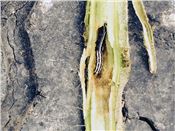Stalk Borer Can Hit Border Row Plants
DR. LEE TOWNSEND
LEXINGTON, KY.
Wilt of a leaf or an entire plant may be the work of the stalk borer (SB), a distinctive striped caterpillar. SB larvae can attack over 150 different plants, including tobacco and corn. Typically, the borers enter plants near grassy field margins or waterways, but they can infest randomly scattered plants across no-till fields. The association with grasses occurs because small borers move from the confines of narrow-stemmed grasses to larger plants where they can finish developing. Movement also can be forced when burn-down herbicides kill their weed hosts.
SB can enter a by chewing into the stem at ground level (tobacco) or by entering from the top (corn). There is no effective way to determine when the borers will move and no insecticide spray will penetrate the stalk to kill the borers once they are inside.
Stalk borer larvae (Figure 1) are brownish purple with narrow white stripes running the length of the body; a bruise-like band encircles the body about one-third of the way back from the head. The head is orange/brown with a dark band on each side.
SB produces one generation each year. Eggs are laid on dead grasses and weeds in the fall, hatching the following year from mid-May through mid-June. ∆
DR. LEE TOWNSEND: Extension Entomologist, University of Kentucky

Figure 1. Common stalk borer in a tomato plant
(Photo: C. Hicks, McLean Co.)